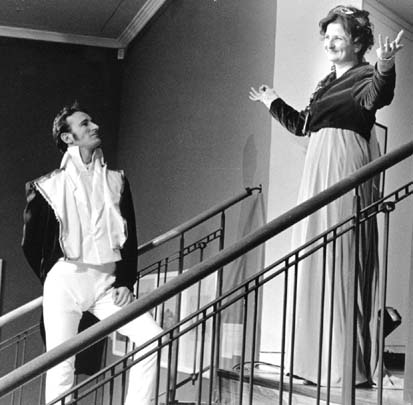SIDLEY PARK & LANDSCAPE GARDENING

Home to the Coverly family over many generations.

Home to the Coverly family over many generations.

HANNAH: �English landscape was invented by gardeners imitating foreign painters who were evoking classical authors - Capability Brown doing Claude, who was doing Virgil. Arcadia!�
The grounds of Sidley Park are subject to changing fashion and taste in gardening during the course of Arcadia. Until 1740, as Hannah Jarvis tells us, the house had a formal Italian garden, and was a �paradise in the age of reason�, with nature subjugated to a sublime geometry of box hedge, pools, fountains, terraces and an avenue of limes. Beauty was symmetry and geometrical patterning. This formal design was then buried beneath the improvements of Lancelot (�Capability�) Brown, the most famous advocate of a �natural� style of gardening which saw beauty only in asymmetrical arrangements of sinuous curves and trees planted in loosely scattered informal groups.
As Arcadia opens, this design is about to give way to the �picturesque� style favoured by Mr Noakes the landscape architect (�the Emperor of Irregularity�). The picturesque was an aesthetic of irregularity, of �romantic� wildness, in which the continuous serpentine lines of Brown were deliberately broken and obscured by sudden declivities and the jagged shapes and shadows of rocks and unkempt trees, with specially made �ruins� to add to the Gothic effect. As Noakes and Thomasina observe, the picturesque style is perfectly epitomised in the paintings of Salvator Rosa, who produced images of towering rocky crags, bare splintered tree trunks and savage lightening storms, peopled by witches and bandits. The Dunedin Public Art Gallery owns a Salvator Rosa which is currently on display in the Bank of New Zealand gallery.
LADY CROOM: Pray, what is this rustic hovel that presumes to superimpose itself on my gazebo?
NOAKES: That is the hermitage, madam.
LADY CROOM: I am bewildered.
BRICE: It is all irregular, Mr Noakes.
NOAKES: It is, sir. Irregularity is one of the chiefest principles of the picturesque style -
LADY CROOM: But Sidley Park is already a picture, and a most amiable picture too. The slopes are green and gentle. The trees are companionably grouped at intervals that show them to advantage. The rill is a serpentine ribbon unwound from the lake peaceably contained by meadows on which the right amount of sheep are tastefully arranged - in short, it is nature as God intended, and I can say with the painter, 'Et in Arcadia ego!' 'Here I am in Arcadia,' Thomasina.

A theory of mine. Ha-hah, not ha-ha. If you were strolling down the garden and all of a sudden the ground gave way at your feet, you're not going to go 'ha-ha', you're going to jump back and go 'ha-hah!', or more probably 'Bloody 'ell!'
Text: Lisa Warrington
Quotations from Tom Stoppard's Arcadia.